
Gamma-ray Burst 980329

The Gamma-Ray Burst (BATSE trigger No. 6665, 22425 cts/s peak intensity)
was detected by BATSE and BeppoSAX GRBM
on 1998 March 29, 3:44:27 UT. With the BeppoSAX WFC the location
could be deduced to a 3 arcmin error circle centered at
R.A. = 07h02m41s, Decl. = +38o50'.7 degrees (2000.0).
This is the brightest burst detected so far by the BeppoSAX
GRBM simultaneously with the Wide Field Cameras. The peak intensity
measured in WFC is about 6 Crab (2 to 26 keV).
A follow-up observation with the BeppoSAX NFI instruments was initiated within
7 hrs. Preliminary analysis of the first 3 orbits of MECS and LECS shows
a source within the WFC error box at
RA (2000) = 105.65
Decl.(2000) = 38.85
with a conservative estimation of the error radius of 2'
A ROSAT TOO observation is being prepared.
(All information courtesy of the instrument teams.)
 Previous IAU Circulars
Previous IAU Circulars
- IAUC
6853 BeppoSAX WFC detection and localisation
- IAUC
6854 BeppoSAX NFI detection of fading X-ray source 1SAX J0702.6+3850
at R.A. = 7h02m36s, Decl. = +38o50'.4
- IAUC
6855 no optical variable brighter than R=22 mag on Mar. 29-31
- IAUC
6856 possible new optical object at 7h02m38s.8, +38o50'27"
- IAUC
6860 no variation of the above optical object between Apr. 1.167-1.177
and Apr. 1.267-1.277
- IAUC
6864 object I=20 mag at radio position on Mar. 29.8-30.0 UT;
I>21 on Mar. 31.8-31.9.
- IAUC
6865 R > 24.2 and > 23.9 on Apr. 1.17 and 3.10 UT at radio position.
- IAUC
6866 J>20.9 at radio position on Apr. 1.167 and 1.277 UT thus dimming
by 1.7 +/- 0.9 over about 2.4 days
- IAUC
6868 JCMT + SCUBA detection at 850 microns at 5 +/- 1.5 mJy
and 4 +/- 1.2 on Apr. 5.2 UT and Apr. 6.2 UT, respectively. Possible
fading to 2 +/- 0.8 mJy on Apr. 7.2 UT.
 Results of Observations
Results of Observations
- Likelihood contour map of the combined COMPTEL and BATSE RBR position
(from comptel.sr.unh.edu/pub/GRB/grb980329_comptel_batsehunts_sys.ps)

- GCN# notice on 31 Mar 1998 17:17:13 UT
Ulysses IPN trianulation arc (see URL's below for actual numbers):
ANNULUS_RA: 154.3013d {+10h 17m 12s} (J2000)
ANNULUS_DEC: 13.1677d {+13d 10' 04"}
ANNULUS_RADIUS: 49.879 [deg]
ANNULUS_WIDTH: 0.089 [deg] (Total width)
COMMENTS: Strong burst. Two overlapping pulses.
COMMENTS: Total duration ~40 sec.
COMMENTS: Seen above 300 keV.
More information about this burst can be found at the GCN URLs:
http://gcn.gsfc.nasa.gov/gcn/gcn_main.html
http://gcn.gsfc.nasa.gov/gcn/batse_grbs.html
http://gcn.gsfc.nasa.gov/gcn/selected.html
- R band image taken at OHP (see IAUC 6856):

- GCN3 notice #40
G.B. Taylor, D.A. Frail (NRAO), S.R. Kulkarni (Caltech), and
the BeppoSAX GRB team report:
We have observed the field containing the proposed x-ray counterpart
1SAX J0702.6+3850 of GRB 980329 (IAUC 6854) with the VLA at 8.4 GHz
on UT 1998 Mar 30.2, April 1.1, and April 2.1. Observations on April
1.1 detected a radio source VLA J0702+3850 within the 1 arcminute
error circle of 1SAX J0702.6+3850. The coordinates of
VLA J0702+3850 are: ra = 07h02m38.02170s dec = 38d50'44.0170" (equinox
J2000) with an uncertainty of 0.05 arcsec in each coordinate. The
size of this radio source is less than 0.25 arcsec. The density of
sources on the sky stronger than 250 microJy at this frequency is
0.0145 arcmin**-2.
The flux density measurements of VLA J0702+3850 are as follows:
Date(UT) 8.4 GHz Flux Density
-------- ----------------------
Mar 30.2 166 +/- 50 microJy
Apr 1.1 248 +/- 16 "
Apr 2.1 65 +/- 25 "
where the uncertainty in the measurement reflects the 1 sigma rms
noise in the image. These measurements clearly demonstrate that
the radio source is variable on timescales of less than 1 day.
This rapid variability is similar to that observed in the
radio afterglow from GRB 970508. We propose VLA J0702+3850
is the radio afterglow from GRB 980329.
Additional radio observations are in progress.
- GCN notice #41
S. G. Djorgovski, S. R. Kulkarni, J. Sievers (Caltech), D. Frail and
G. Taylor (NRAO), on behalf of the Caltech-NRAO GRB collaboration, report:
We have detected a galaxy coincident to within the astrometric errors (about
0.5 arcsec) with the variable radio source detected at the VLA by Taylor et al.
(see GCNC#40) on deep R-band images taken with the Keck-II 10-m telescope
on 02 April 1998 UT. The galaxy has a magnitude R = 25.7 +- 0.3 (preliminary
reductions).
We propose that this is the host galaxy of the radio transient detected at the
VLA, which may be the afterglow of GRB 980329.
The image of the field is shown at
http://astro.caltech.edu/~george/grb/grb980329.html (and below).
 One of the CCD images in the R band obtained at the Keck-II
telescope on UT 1998 April 02. The field shown is approximately
168 arcsec square. This is a preliminary reduction.
One of the CCD images in the R band obtained at the Keck-II
telescope on UT 1998 April 02. The field shown is approximately
168 arcsec square. This is a preliminary reduction.
 A zoom-in from a CCD image in the R band obtained at the
Keck-II telescope on UT 1998 April 02, with the possible GRB
host galaxy marked. The field shown is about 42 arcsec square.
This is a preliminary reduction of the data.
A zoom-in from a CCD image in the R band obtained at the
Keck-II telescope on UT 1998 April 02, with the possible GRB
host galaxy marked. The field shown is about 42 arcsec square.
This is a preliminary reduction of the data.
- GCN notice #43
Sylvio Klose, Thueringer Landessternwarte Tautenburg, Germany, reports:
I-Band images obtained on March on March 29.8-30.0 UT, using the
Tautenburg Schmidt telescope equipped with the Schmidt focus CCD camera
show an object at the position of the radio source reported by
Taylor et al. [GCN Circ #40].
This object was not visible on the I-band images taken on March 31.8-31.9 UT
with the Tautenburg telescope (GCN #36). It was also not found on an I-band
image taken on April 1.85 UT by H. Lehmann and H. Meusinger, Thueringer
Landessternwarte, with the Calar Alto 2.2-m telescope equipped with CAFOS.
Since no R-band counterpart was seen on the Tautenburg images taken on
March 29.8-30.0 UT, I hesitate to claim the detection of this source.
This object is visible on various I-band frames, and also appears
if flat-fielding is not performed. Its magnitude is about I=20,
but I do not have a photometric standard.
These Tautenburg I-band Images are availabe via anonymous ftp from
ftp.tls-tautenburg.de in the directory /pub/klose.
- GCN notice #44
J. Larkin, A. Ghez (UCLA) in collaboration with S. Kulkarni,
S. Djorgovski (Caltech), D. Frail, and G. Taylor (NRAO) report:
We have detected a near infrared counterpart to the variable radio
source detected at the VLA by Taylor et al. (see GCNC#40),
the R-band source reported by Djorgovski et al. (see GCNC#41), and
the possible I-band transient reported by Klose (GCNC#43). Preliminary
analysis of observations obtained on UT 1998 April 02 and April 03 at
the Keck-I 10-m telescope reveal a K = 21.0 mag source that does not
show strong variations (delta K < 0.5 mag). The infrared, optical and radio
positions all agree to within the astrometric uncertainties of about
0.5 arcsecond.
We suggest that a possible explanation for the relatively red color
of the host galaxy (R-K = 4.7 mag) and the lack of optical transient
detections may be dust obscuration.
- GCN notice #45
Bradley E. Schaefer at Yale Univ. reports:
R-band observations of the GRB980329 error box were obtained with the
3.5 m WIYN telescope on Kitt Peak on UT 1998 April 1.17 and April 3.10.
The position of the radio transient (see GCNC #40) was empty to limits of
24.2 and 23.9 mag respectively.
- GCN notice #46
F. Mannucci, M. Salvati, P. Tozzi, Osservatorio Astrofisico di Arcetri,
Firenze, Italy, M. Di Martino, Osservatorio Astronomico di Torino, Italy,
E. Palazzi and E. Pian, Istituto di Tecnologie e Studio delle Radiazioni
Extraterrestri, CNR, Bologna, Italy, on behalf of a large collaboration
report:
On March 29.84-29.86 UT, the SAX-WFC error box of GRB980329 (IAUC 6853)
was imaged at the Gornergrat Infrared Telescope (TIRGO) with ARNICA + J
band filter. A preliminary analysis of the data shows that the galaxy
reported by Djorgovski et al. (GCNC #41) is detected at 2-sigma
significance with a magnitude J = 19.2 (+0.8,-0.5 at 1 sigma).
- GCN notice #47
D. M. Cole, A. R. Cooray, J. M. Quashnock, D. E. Vanden Berk,
D. Q. Lamb, D. E. Reichart, G. T. Richards, K. Gloria, D. Long, and
T. Hoyes, University of Chicago, on behalf of the
Astrophysical Research Consortium (ARC), report:
"We made near-infrared observations (GCN #39, IAUC 6860)
of the SAX NFI error box for GRB 980329 (IAUC 6853, 6854)
between Apr. 1.167 UT and Apr. 1.277 UT, using the GRIM II instrument
mounted on the ARC 3.5-m telescope at Apache Point Observatory.
We find no detectable object, down to a limiting J magnitude of 20.9 +/- 0.5
(1 sigma) at the position R.A. = 7h02m38s.02, Decl. = +38o50'44" (J2000.0) of
the variable radio source VLA J0702+3850 proposed by Taylor et al. (GCN #40)
to be the radio afterglow from GRB 980329. The measurement by Mannuci et al.
(GCN #46) of a magnitude J = 19.2 (+0.8,-0.5) object at the position
of the radio source at epoch Mar. 29.84-29.86 UT implies
that this object dimmed by J magnitude 1.7 +/- 0.9
during a period of approximately 2.4 days."
- GCN notice #48
E. Palazzi, N. Masetti, E. Pian, F. Frontera (ITeSRE-CNR, Bologna), L.
Nicastro (IFCAI-CNR, Palermo), P. Vreeswijk, T. Galama, P. Groot, J. van
Paradijs (U. Amsterdam), M. Della Valle (Oss. Astr. Padova), E. Costa,
M. Feroci, L. Piro (IAS-CNR, Rome), C. Kouveliotou (MSFC-NASA), and
C. Lidman (ESO) report:
The error box of GRB980329 (IAUC 6853) was observed with the NTT at ESO
(La Silla, Chile) on March 29.99, 30.99 and April 1.01 UT with EMMI in R
and V band filters. Observations lasted 10+10 minutes per filter per
night. Limiting magnitudes were ~24.0 in R and 23 in V. On March 29.99,
at the position RA = 07h02m38s, Dec = +38deg50'44".1 (J2000), coincident
(to within the astrometric errors) with VLA J0702+3850 (GCN #40) and with
the galaxy reported by Djorgovski et al. (GCN #41), we detect an R = 23.5
(+/- 0.2) object. The source is not detected in V, and in the subsequent
nights is undetected in both bands. Using R = 25.7 (April 2, Djorgovski
et al., GCN #41) we obtain a luminosity power-law decay index <~ -1.3.
The extrapolation of this power-law to the time of the observations reported
by Guarnieri et al. (GCN #37, Mar 29.79), Brocato et al. and Cappellaro
(see below) is consistent with their non-detections. The NTT R band images
can be found at the Web site
http://www.tesre.bo.cnr.it/~nicastro/grb980329 (and is reproduced below),
as well as the TIRGO J band images reported in GCN #46.

March 29.99: NTT + EMMI + R-band filter, 20 min exposure.

March 30.99: NTT + EMMI + R-band filter, 20 min exposure.
E. Brocato, A. Piersimoni, and G. Raimondo (Oss. Astr. Teramo) report:
We imaged the GRB980329 error circle with the 0.72-m telescope at Campo
Imperatore (Teramo) equipped with a Tek-CCD and R band filter on March
29.83 UT for 1800 s. No object brighter than R = 20 is detected at the
VLA source position.
E. Cappellaro (Oss. Astr. Padova) reports: On March 29.81 and 29.99 UT,
the GRB980329 error circle was imaged for 1500 s using the 1.8-m telescope
at the Asiago observatory with AFOSC and R band filter. Down to a limiting
magnitude of R = 21, no object is found at the VLA source position.
- GCN notice #49
K. Hurley (UCB) on behalf of the Ulysses GRB team,
M. Feroci (IAS/CNR, Rome) and F. Frontera (ITESRE/CNR, Bologna)
on behalf of the BeppoSAX/GRBM Team report:
We have derived a preliminary IPN annulus for this burst using
Ulysses and the BeppoSAX Gamma-Ray Burst Monitor. The annulus
is described by a circle of radius of 49.898 degrees centered at
RA(2000) = 154.298 degrees, Declination (2000) = 13.169 degrees.
The half-width of the annulus is 0.022 degrees. The annulus
intersects the WFC error circle (IAUC 6853) and reduces its area.
The intersection points are:
RA(2000) Decl (2000)
105.628 o = 7 H 2 M 30 S 38.808 o = 38 o 48 ' 29 "
105.662 o = 7 H 2 M 38 S 38.895 o = 38 o 53 ' 40 "
105.683 o = 7 H 2 M 43 S 38.796 o = 38 o 47 ' 45 "
105.716 o = 7 H 2 M 51 S 38.880 o = 38 o 52 ' 49 "
This error box includes the SAX NFI X-ray source (IAUC 6854), radio
source (GCN #40) and the optical transient (GCN #48). Further processing
will reduce the annulus width. An image may be found at
http://ssl.berkeley.edu/ipn3/980329/ .
- GCN notice #50
I. A. Smith (Rice University) and R. P. J. Tilanus (Joint Astronomy Centre)
report on behalf of the James Clerk Maxwell Telescope (JCMT) GRB collaboration:
We used the SCUBA sub-millimeter continuum bolometer array on the JCMT to
observe the variable radio source VLA J0702+3850 proposed by Taylor et al.
(GCN #40) as the radio afterglow to GRB 980329.
On UT 1998 April 5.2 we detected a source at 850 microns with a preliminary
flux density of 5 +/- 1.5 mJy. This source was confirmed on April 6.2 with
a flux density of 4 +/- 1.2 mJy, resulting in an average of 4.5 +/- 1 mJy
over the two days. The 850 micron source is present in all our separate
integrations making us confident it is real. A hint of a fading trend
appears to be confirmed by observations on April 7.2 when the (preliminary)
850 micron flux density was 2 +/- 0.8 mJy.
The source was not detected at 450 microns with a preliminary rms of 10.0
mJy averaged over the first two days.
Assuming these fluxes are due to the burst counterpart, they should represent
"clean" measures of its intensity, unaffected by scintillation and extinction.
Monitoring with SCUBA is continuing.
We wish to thank Dr. L. Avery and Dr. J. MacLeod for their cooperation and
valuable help in obtaining these observations, and Dr. G. Watt and Dr. I.
Robson for rapidly scheduling the observations.
- GCN notice #51
J. Larkin and A. Ghez (UCLA) in collaboration with S. Kulkarni,
S. Djorgovsk (Caltech), D. Frail and G. Taylor (NRAO) report:
We have fully reduced our K-band images of the field surrounding the
gamma ray burst GRB980329. We confirm our earlier strong detection of
a compact (<0.6'' FWHM) object at the radio coordinates reported by
Taylor et al. (see GCN#40) and coincident with the optical counterpart
announced by Djorgovski et al. (see GCN#41). The observations include
two separate 90 minute exposures at the Keck 10 meter telescope
obtained on UT 1998 April 02 and April 03, respectively. The total
K-band magnitudes of the object are 20.7+-0.2 mag on April 02, and
20.9+-0.2 mag on April 03. The source is unresolved in our images,
even if we include only those frames taken under the best seeing
conditions of 0.5 to 0.6 arcseconds.
The final K band image can be found at
http://www.astro.ucla.edu/~larkin/grb.html
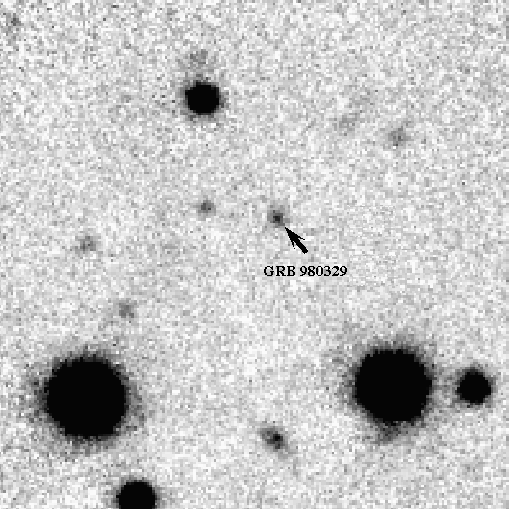
- GCN notice #52
H.Pedersen (Copenhagen University Observatory),
J.Fynbo (Institute of Physics and Astronomy, Aarhus),
E.Valtaoja (Tuorla Observatory, Turku),
M.Tornikoski (Metsahovi Radio Observatory, Helsinki),
J.Clasen (Nordic Optical Telescope, La Palma), and
E.Palazzi (Istituto TeSRE, Bologna), report:
Using the 2.56 m Nordic Optical Telescope, La Palma,
we have obtained a total of seven 600 s R band exposures
of the proposed host galaxy (ref. GCN #41, #51).
The exposures were taken March 30.924 - 30.942 (2 exp.),
March 31.866 - 31.882 (2 exp.), and April 01.879 - 02.029 (3 exp.).
One 300 s I band exposure was obtained on March 31.919.
The optical transient is not clearly detected in any single
exposure, nor in the sum of exposures from any night. However,
the sum of all R exposures shows a very faint object at the
cited position for which we derive m(R) = 24.8 +/- 0.5
(using the R=15.8 object from IAU Circ. No. 6856 as calibration).
The data files can be retrieved from
http://www.astro.ku.dk/~holger/g/IMAGES/GRB980329/NOT_R.fits.gz and
.../NOT_I.fits.gz
Further to this, H.Pedersen reports:
Using the 45/77 cm Brorfelde Schmidt, a series of seventeen
500 s R band exposures were obtained March 29.860 - 29.973.
None of these exposures shows any object at the position of
the optical counterpart. During the observing interval, the
detection limit deteriorated gradually, from R=18.5 to 18.0
K.Augustesen kindly performed the Schmidt observations.
- GCN notice #55
M.R. Metzger (Caltech) reports:
Near-infrared K-band images of the area surrounding the variable radio source
detected by Taylor et al. (GCNC #40), possibly associated with GRB 980329
(IAUC 6853, 6854), were obtained on Apr 6.27 and Apr 8.28 with the Keck-I
10m telescope. The source reported by Larkin et al. (GCNC #51, coincident
with the galaxy reported by Djorgovski et al., GCNC #41) was detected on
both nights, at K=21.4 +/- 0.2 mag (6.27) and K = 21.9 +- 0.4 mag (8.28).
Comparison with the magnitudes reported by Larkin et al. indicates that the
source has faded by about 1 mag between Apr 2.3 and Apr 8.28. This suggests
that part of the K flux may be IR afterglow of GRB 980329. It is consistent
with fading, detections, and upper limits reported previously (GCNC #41,
#46, #48, IAUC 6864, 6866, 6868). Further measurements are suggested to
estimate the IR brightness of any underlying host.
- GCN notice #59
J. Greiner (AI Potsdam, Germany), W. Voges (MPE Garching) and F. Frontera
(Bologna, Italy), E. Costa and L. Piro (IAS Rome, Italy) report:
A ROSAT target-of-opportunity observation was performed towards the position
of GRB 980329 (IAUC 6853) between April 1--3, 1998. The total exposure time
was 33.5 ksec. No X-ray source is detected within the WFC error box at
the 3 sigma significance level or higher (upper limit of 0.0001 cts/s).
Adopting a power law spectrum with photon index of 2.0 and only galactic
absorption (9*10^20 cm^-2), this corresponds to a flux limit of
9.3E-15 erg/cm^2/s in the 0.1-2.4 keV band. The non-detection of the
X-ray afterglow source 1SAX J0702.6+3850 as detected with the BeppoSAX NFI
(IAUC 6854) implies that the X-ray flux of the GRB 980329 afterglow decayed
according to t^-1.8 or steeper.
An image of the ROSAT observation is shown below (inner 15 arcmin):
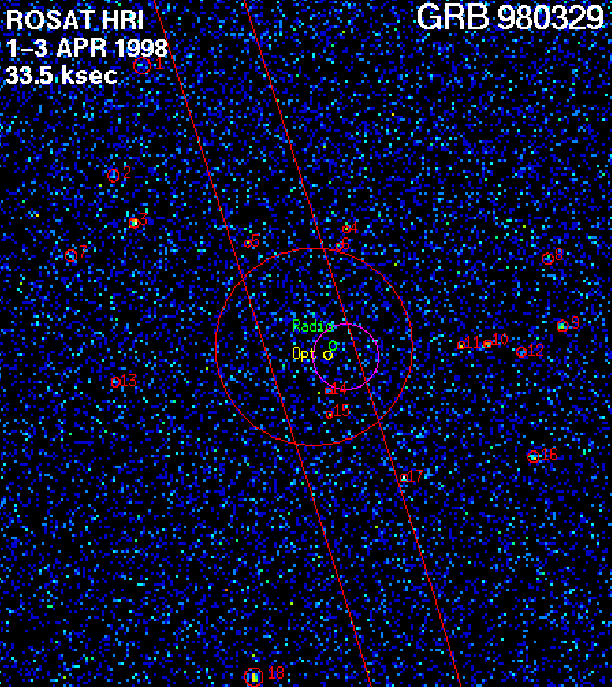
- The following figures are from Taylor et al: The Discovery of the Radio
Afterglow From the Optically Dim GRB of March 29, 1998 (astro-ph/9805333).
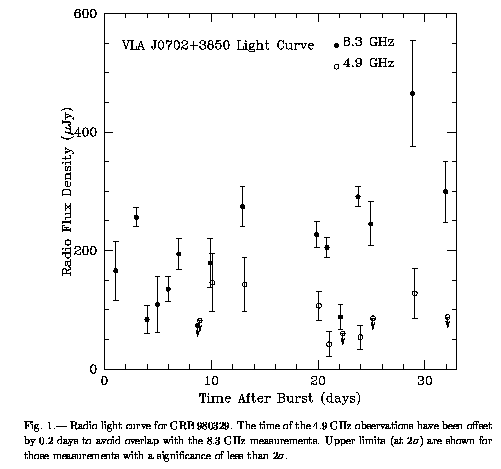
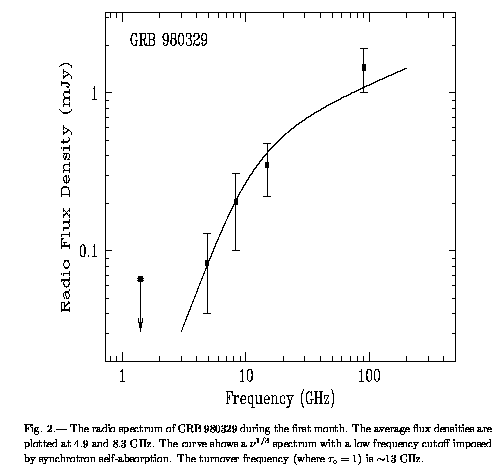
- Decay lightcurve in the X-rays (astro-ph/9807314):

- Photometry suggests z=5 (astro-ph/9810224):

- GCN notice #157
James Rhoads, Arjun Dey, Buell Jannuzi, and Megan Sosey (on behalf of
the KPNO GRB followup team); Sylvio Klose; Daniel Reichart; Andrew
Fruchter; and Francisco Castander report:
We have used data obtained by Rhoads on the night of 980403 UT to
calibrate Klose's I band measurement of the optical transient
associated with GRB 980329 (GCNC #43). We find an optical transient
magnitude I=20.8 +- 0.3 on March 29.8-30.0 (cf. Reichart et al, in
preparation). The corresponding flux density is 11 +- 3 microJansky.
The data consisted of 1200 seconds integration per filter on the GRB
980329 field in R band (April 3.147) and I band (April 3.167) at
airmass 1.1, plus brief R and I band observations of the SA107 field
at airmass 1.4. The data were taken with the 4 meter Mayall telescope
and Mosaic CCD Imager at Kitt Peak National Observatory. Weather was
photometric with poor image quality (from 1.25 to 1.75 arcsec).
Details of the photometric calibration and a table of reference star
magnitudes in the GRB 980329 field are at the end of this circular.
We used the same data to measure the flux at the location of the
transient. No obvious source is present at the location of the
transient (7:02:38.0 +38:50:44 J2000.0) in either filter. R band
photometry using a 0.75 and 1.25 arcsecond radius apertures, corrected
for aperture losses using the curve of growth, yield flux estimates
of 0.40 +- 0.25 and 0.80 +- 0.25 microJansky, where the error bar
includes contributions from photon counting noise and from sky
subtraction uncertainties only. Conservatively, this gives a 3 sigma
upper limit of 1.50 microJansky (for a one-sided confidence interval
with probability 99.73%) and R > 23.3 magnitudes.
In addition, we report a K band upper limit using data obtained by
Dey, Jannuzi, and Sosey (on behalf of the NOAO Deep Widefield Survey
team) on 1998 April 3.205 using the Kitt Peak National Observatory 2.1
meter telescope and ONIS camera. No point source is apparent at the
location of the transient. The RMS counts in the image imply a 3
sigma upper limit of 13.4 microJansky for a point source (in a 1
arcsec radius aperture and corrected using the curve of growth),
which corresponds to K > 19.2 at the 3 sigma level.
- Details of the photometric calibrations -
Reliable optical fluxes were measured for the Landolt standard stars
SA107-212, 213, 357, 359, 351, 457, 456, 600, 599, 612, 626, and 627.
Standard star and GRB field photometry was done in a similar fashion,
with growth curves derived from multiaperture photometry used to
correct all magnitudes to an effective 7" radius. The photometric
errors in the GRB frame were taken from the IRAF "mkapfile" task,
which applies the aperture corrections. Additional errors were added
in quadrature to account for uncertainties in the photometric zero
point (+- 0.004 mag in both R and I), color correction terms (+-
0.07*[R-I - 0.42]), and airmass correction term (+- 0.01 mag for I
band and +- 0.024 mag for R band).
The table of measured magnitudes for objects near GRB 980329:
# RA (J2000) Dec R err(R) I err(I)
7:02:39.0 38:50:32.7 15.7 1.0 15.300 0.2
7:02:37.5 38:50:33.5 15.85 1.0 15.450 0.12
7:02:35.1 38:50:23.2 16.30 0.3 15.988 0.036
7:02:40.1 38:50:11.8 16.9664 0.0314 16.647 0.0155
7:02:39.4 38:50:03.1 18.4428 0.0275 18.093 0.0175
7:02:38.7 38:50:26.9 20.655 0.0646 19.473 0.0623
7:02:36.6 38:50:36.3 20.3862 0.0536 19.331 0.0478
7:02:36.3 38:50:19.8 20.5135 0.0464 19.625 0.0459
7:02:38.4 38:50:50.7 21.2876 0.0688 20.026 0.0711
7:02:51.0 38:49:31.0 17.6592 0.0456 16.668 0.0399
7:02:50.4 38:49:57.1 17.9663 0.0258 17.539 0.0161
Users of this table should be aware that the magnitude uncertainties
for the different stars include some sources of systematic error
(airmass and color terms) that are not independent from star to star.
Also, the first two entries are substantially saturated in R and I;
the third is substantially saturated in R and perhaps marginally in I;
and the fourth may be marginally saturated in R. Photometric errors
quoted for saturated stars are approximate guesses.
More detail, and sections of the processed R and I band images, are
available from
http://www.noao.edu/noao/grb/980329.html.
- light curve from Reichart etal (astro-ph/9806081 = ApJ 517, 1999, 692)
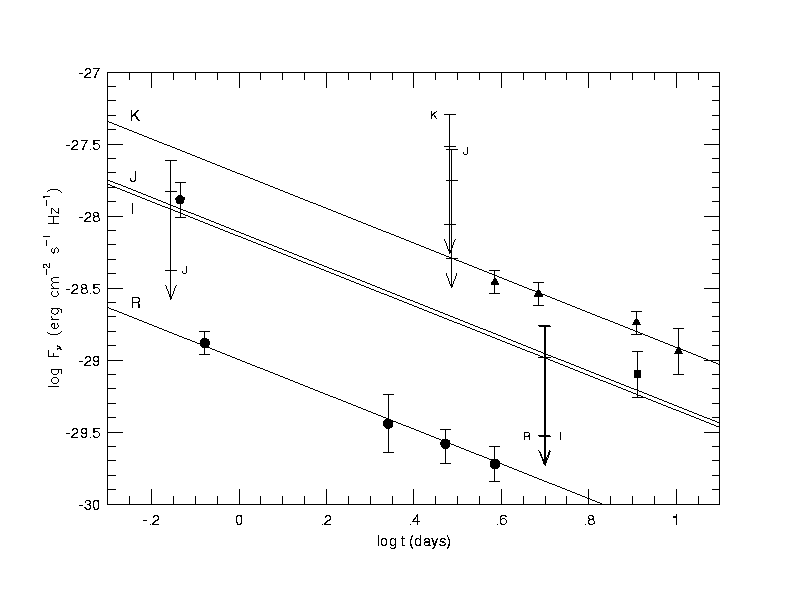
- Redshift determinations:
either 2 or 3 < z < 5 (Lamb et al 1999, AAS 338, 479)
< 3.9 (Djorgovski et al 1999, Santa Barbara)
- GCN notice #778
Stephen Holland, Bjarne Thomsen (University of Aarhus),
Jens Hjorth, Johan Fynbo (University of Copenhagen),
Michael Andersen (University of Oulu),
Gunnlaugur Bjornsson (University of Iceland),
Andreas Jaunsen (ESO),
Priya Natarajan (University of Cambridge, & Yale), and
Nial Tanvir (University of Hertfordshire)
We have used the Space Telescope Imaging Spectrograph (STIS) on
the Hubble Space Telescope to image the host galaxy of GRB 980329. We
obtained 8072 seconds of STIS/CCD images with the 50CCD (clear)
aperture and 5416 seconds with the F28X50LP (long pass) aperture.
This data was taken as part of the Survey of the Host Galaxies of
Gamma-Ray Bursts (Holland et al., GCN 698) approximately 880 days
after the burst occurred. Combined images are now available at
http://www.ifa.au.dk/~hst/grb_hosts/data/index.html. The drizzled
F28X50LP image is based on two orbits worth of data, and will be
updated when the data from the third orbit is available.
A preliminary determination of the location of the radio
transient VLA J070238.0+385044 associated with GRB 980329 (Taylor et
al. 1998, ApJL, 502, L115), based on the astrometry of three USNO-A2.0
stars, is (X,Y) = (1039,1027) where the three-sigma uncertainty in the
astrometric solution is 20 drizzled STIS pixels (0.5 arcsec). There
is a faint, extended object at (X,Y) = (1031,999) in our drizzled
50CCD image. This object is also visible in the F28X50LP image. The
object is approximately three sigma southwest of the position of the
GRB, and is the best candidate for the host galaxy of GRB 980329. An
image showing the location of the galaxy and the GRB is available at
http://www.ifa.au.dk/~hst/grb_hosts/data/grb980329cd.gif. The
probable host galaxy has AB magnitudes, in an aperture of radius 0.25
arcsec, of CL = 28.6 +/- 0.3 and LP = 28.1 +/- 0.3. If we assume that
the galaxy has a power-law spectrum then the preliminary Kron-Cousins
R-band magnitude is R = 27.7 +/- 0.3. We also derived a preliminary
calibration based on two stars from Rhoads et al. (GCN 157) and found
R = 28.2 +/- 0.3. These results are consistent with each other, and
are consistent with the host magnitude being 26.8 < R < 29, as
determined by Gorosabel et al. (1999, A&A, 347, L31) from the decay of
the optical light curve. The faintness of the galaxy is consistent
with it having a redshift of z > 2 (Fruchter 1999, ApJ 512, L1; Lamb
et al. 1999, A&AS, 138, 479), although we can not rule out z < 2 from
the HST/STIS data alone.
- Photometric redshift z~3.5:
Jaunsen et al. 2003, A&A 402, 125
Back to JG's
homepage
Jochen Greiner, last update: 13-Aug-2010
[Disclaimer]
![]() Previous IAU Circulars
Previous IAU Circulars 









